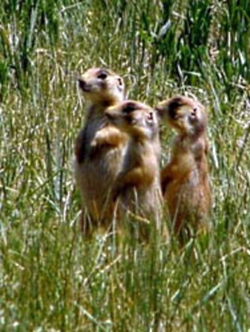
Cynomys parvidens
Courtesy US NPS, Bryce Canyon NP
 White-tailed Prairie Dog
White-tailed Prairie Dog
Cynomys leucurus
Courtesy US FWS
Rhonda Foley, Photographer
Throughout certain areas in southwestern Utah, construction is currently underway. New neighborhoods and subdivisions are being worked on daily, with mounds of dirt displaced. But this isn’t your typical suburban development. Its inhabitants are only 12 inches tall and furry.
The Utah prairie dog is the westernmost of five prairie dog species in the US and is unfortunately the most threatened. Since 1973 it has been a regular feature on the endangered species list, though it was downgraded to ‘threatened’ in 1984 and populations continue to show signs of growth.
Utah prairie dogs are very social creatures, living in large groups called colonies or towns which consist of hundreds or even thousands of individuals and their vast networks of underground burrows. While the group forages for grasses, seeds, leaves, and insects, colony guards or lookouts take turns watching for danger. If a hazard is identified, loud barks echo throughout the colony and foraging dogs run for cover.
Earlier this spring, Utah Prairie dogs in Parowan made national news when the town started construction on a $300,000 fence to keep these industrious critters from burrowing under and buckling the local airport’s runway. Their threatened status means special care must be taken in removing the dogs from airport property and relocating them to nearby public lands. Airport personnel waited until the beginning of July, after this year’s offspring had matured and left home, to begin the specialized trapping and relocation process.
While some consider prairie dogs and their digging habits to be a nuisance, these diminutive creatures are an incredibly important part of their ecosystem. Ecologists have a name for organisms whose role is disproportionately large – a keystone species. In architecture, a keystone is the uppermost piece in an arch – the one on which all the other stones lean. Ecologically speaking a keystone species is one that supports many others that live around it.
It has been estimated that more than 170 species – many of them also threatened or endangered – depend in some way on the Utah prairie dog, generally for either food or shelter. For example, the quirky and unique burrowing owl depends upon abandoned prairie dog homes for constructing its underground nests. Black – footed ferrets, whose population was at one time reduced to only 18 individuals, inhabit abandoned burrows within a large prairie dog colony and rely almost 100% upon the rodents for food.
Other animals that are linked to the Utah prairie dog include badgers, coyotes, sage grouse, Swainson’s hawks, and kit foxes. Like its architectural counterpart, if an ecological keystone is removed the whole system is prone to collapse. Thankfully, with a species recovery plan in place, and a dedicated inter-agency group of supporters, the Utah prairie dog’s housing market continues to boom.
Thank you to the Rocky Mountain Power Foundation for supporting the research and development of this Wild About Utah topic.
For the Stokes Nature Center and Wild About Utah, this is Andrea Liberatore.
Credits:
Images: Courtesy & US FWS, images.fws.gov
Courtesy US NPS, https://www.nps.gov/brca/naturescience/upd.htm
Text: Andrea Liberatore, Stokes Nature Center in Logan Canyon.
Additional Reading:
Hengesbaugh, M.G. (2001) Creatures of Habitat: The Changing Nature of Wildlife and Wild Places in Utah and the Intermountain West. Utah State University Press: Logan, UT,
U.S. Fish & Wildlife Service – Mountain-Prairie Region. (2012) Endangered Species: Utah Prairie Dog. Available online at: https://www.fws.gov/mountain-prairie/species/mammals/UTprairiedog/
National Park Service – Bryce Canyon National Park, Utah. (2012) Utah Prairie Dog. Available online at: https://www.nps.gov/brca/naturescience/upd.htm
Carlton, J. (2012) In Utah, A Town Digs Deep to Battle Prairie Dogs. Wall Street Journal, May 6 2012. Available online at: https://online.wsj.com/article/SB10001424052702304020104577384642186959960.html
